For this 6th episode of the Notebooks of Egypt, the research mission which studies the paintings of the Theban tombs details the scientific imaging techniques that make possible the rigorous study of the paintings of the Egyptian tombs. They make it possible to reveal a multitude of details on the practices of the painters.
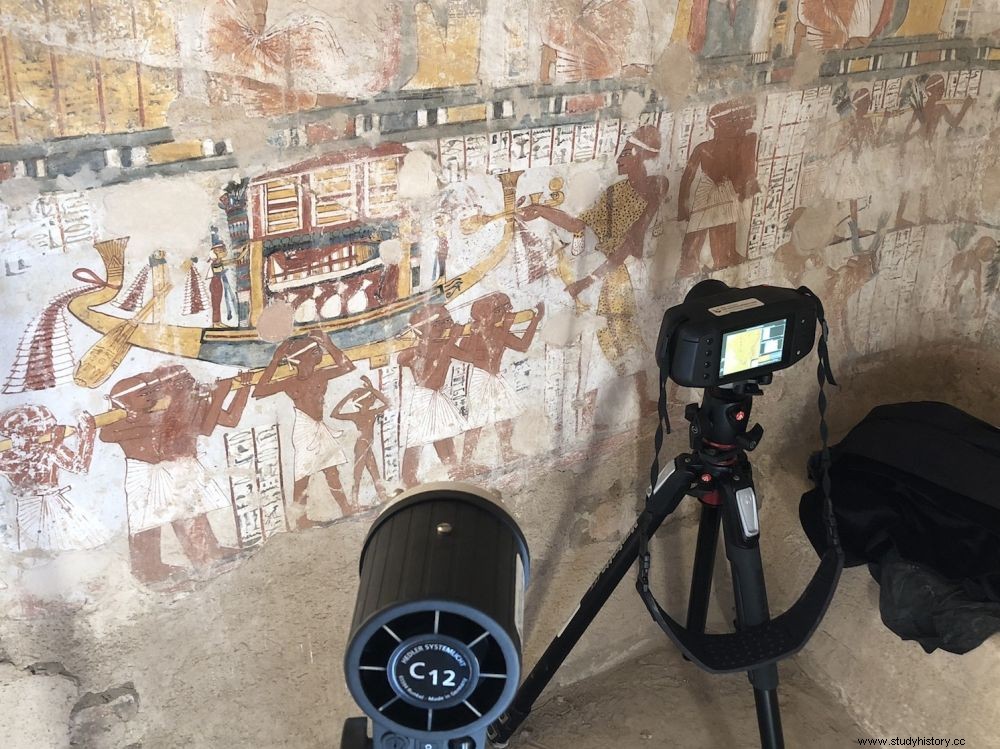
Device for recording hyperspectral images:this technique combines imaging and spectroscopy. While a camera records the image in three bands (red, green and blue), hyperspectral imaging makes it possible to measure a very large number of bands ranging from visible to near infrared (from 400 nm to 1000 nm).
Scientific imaging techniques show their performance every day in many areas of daily life. The uses of ultraviolet light at a crime scene or X-rays for medical diagnosis are practices that have become obvious to the police or the doctor. For the exploration of the paintings of the Egyptian tombs in Luxor, the research team which associates the Molecular and Structural Archeology Laboratory (Sorbonne University-CNRS) and the European Center for Archaeometry of the University of Liège has chosen to use a camera modified to detect infrared as well as a hyperspectral analysis instrument that measures with great precision how light is scattered by the paint.
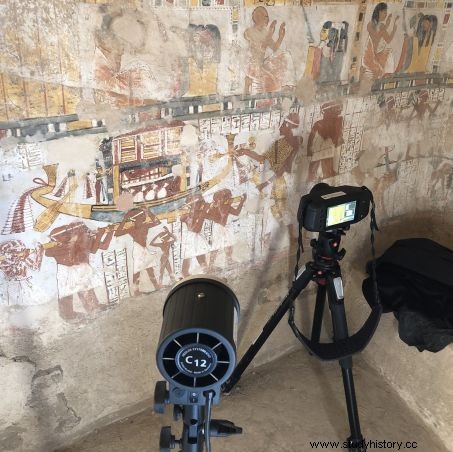
Hyperspectral Image Recording Device:This technique combines imaging and spectroscopy. While a camera records the image in three bands (red, green and blue), hyperspectral imaging makes it possible to measure a very large number of bands ranging from visible to near infrared (from 400 nm to 1000 nm). ©MAFTO-LAMS/CNRS
Carbon black absorbs all visible and infrared light
One of the pigments used by painters, carbon black, appears easily on the documents obtained by these techniques, because the carbon absorbs almost completely the visible and infrared light which is used during these measurements. This is how we can observe black lines that are below the pictorial layer and even find them when they are only present in traces. While most of the pictorial layers are very well preserved nearly 3,500 years after their creation, a singular phenomenon appears for the black lines:the paint seems to have peeled off the wall and only a phantom imprint is still present:it then becomes sometimes very difficult to read hieroglyphic texts and some outlines of the figures have disappeared. A statistical treatment on the photographs, or better on the hyperspectral images, makes it possible to reveal the missing signs.
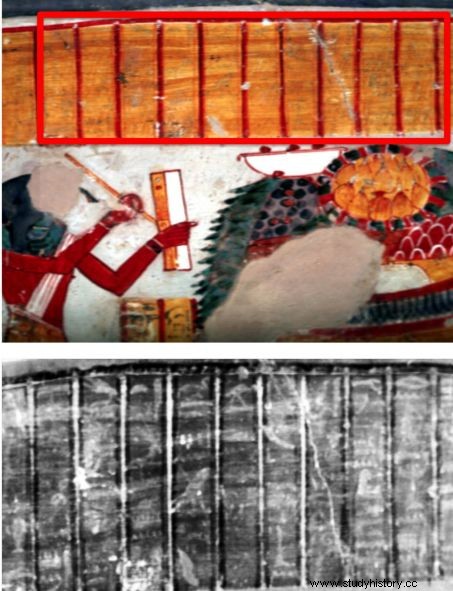
Photograph of one of the walls of the tomb of Nakhamon. The processing of the hyperspectral image obtained makes it possible to read most of the hieroglyphs that have now almost disappeared. ©MAFTO-LAMS/CNRS
For blue, just look at it in infrared
The Egyptian blue pigment has a rare property for a mineral substance:when illuminated with visible light, it emits infrared light. This phenomenon, called luminescence, is so strong that the presence of traces of this pigment can be detected while the blue color is invisible to the naked eye.
This property now gives it a new technological appeal and researchers have recently thought of applications of this substance as an amplifier in the field of telecommunications and for the manufacture of lasers. Based on this observation, researchers from the Department of Energy at the American National Laboratory Lawrence Berkeley recently published an article in the Journal of Applied Physics showing that the use of Egyptian blue can be effective in industrial paints:it would cool roofs exposed to the sun and thus reduce energy consumption by air conditioners. Physicists and chemists today are looking at materials invented in the past and finding amazing new applications for them.
By applying this phenomenon to research on Egyptian tombs and illuminating the works with light-emitting diode (LED) lamps, because they do not emit infrared, a camera modified to see in the infrared quickly detects the blue pigment Egyptian by its luminescence:the image obtained reveals its distribution on the wall.
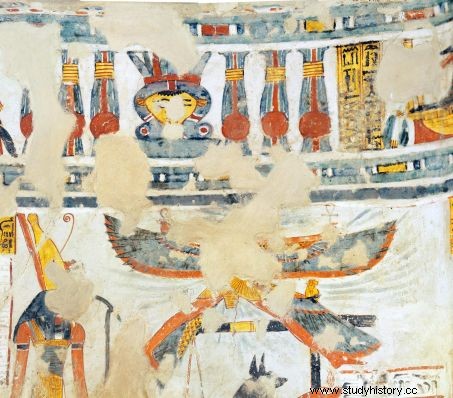
Nakhtamon victorious in the test of the weighing of the heart:the heart was for the ancient Egyptians the seat of feelings and decisions. At the time of death, he must have been lighter than a feather. Nakhtamon, having successfully passed this ordeal, rises with a beating of wings, justified before Osiris and transformed into a semi-divine being. ©MAFTO-LAMS/CNRS
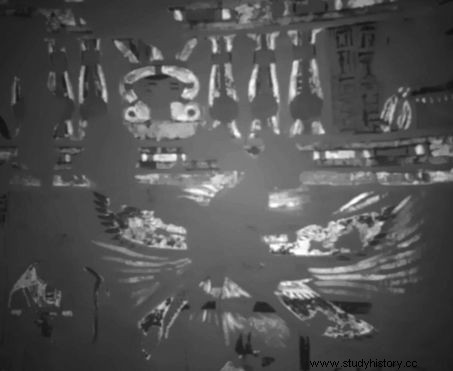
The same scene in the infrared:in white, the Egyptian blue which is luminescent; in black, carbon black which absorbs all infrared. The artist used edgy touches of blue to evoke the air stirred by the movement of Nakhtamon's wings. ©MAFTO-LAMS/CNRS
Notebooks of Egypt, 1st episode:how did the painters of ancient Egypt work?
Notebooks from Egypt, 2nd episode:Discovering the funeral chapel of Nakhtamon.
Notebooks from Egypt, 3rd episode:The pigments of Egyptian painting.
Notebooks from Egypt, 4th episode:The modern documentation of painted walls.
Notebooks from Egypt, 5th episode:Rediscovering the monuments of eternity of Ramses II.
Notebooks from Egypt, 6th episode:Revealing pigments with light:the visible and the invisible.
Notebooks from Egypt, 7th episode:Experiencing research through images.
Notebooks of Egypt, 8th episode:Beginning of the study of the paintings of the tomb of Nebamon and Ipouky.
Notebooks from Egypt, 9th episode:A tomb shared by two artists under Amenhotep III.
Notebooks from Egypt, 10th episode:What the tomb of Amenouahsou, an artist from ancient Egypt, reveals.
Notebooks from Egypt, 11th episode:Strange uses that have been made of Egyptian mummies.
Notebooks from Egypt, 12th episode:"Why don't all the artists come here?"
Notebooks of Egypt, 13th episode:Why did the Egyptians draw the characters in profile?
Notebooks from Egypt, 14th episode:Observing craft practices in Egyptian tombs.
Notebooks from Egypt, 15th episode:About Egyptian perfumes.
Notebooks from Egypt, 16th episode:The colors of the Egyptian palette.
Notebooks of Egypt, 17th episode:The Egyptian language does not know a word to designate "art".
Notebooks of Egypt, 18th episode:The day of a scientific mission in Egypt.
